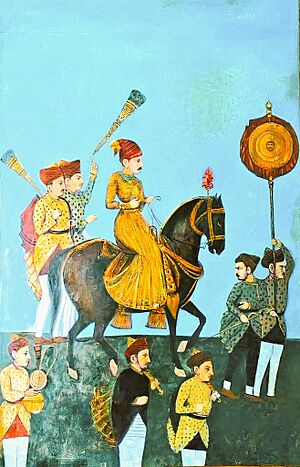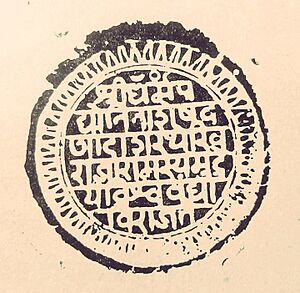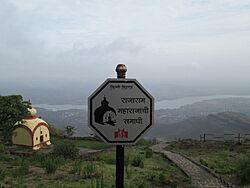Rajaram I facts for kids
Quick facts for kids Rajaram I |
|
|---|---|
 |
|
| 3rd Chhatrapati of the Marathas | |
| Reign | 11 March 1689– 3 March 1700 |
| Coronation | 12 February 1689 |
| Predecessor | Sambhaji |
| Successor | Shivaji II |
| Peshwa | Ramchandra Pant Amatya |
| Born | 24 February 1670 Rajgad Fort, Ahmadnagar Subah, Mughal Empire (present-day Pune district, Maharashtra, India) |
| Died | 3 March 1700 (aged 30) Sinhagad Fort, Maratha Empire |
| Spouse | Jankibai Tarabai Rajasbai Ambikabai |
| Issue | Shivaji II Sambhaji II Karna |
| House | Bhonsle |
| Father | Shivaji I |
| Mother | Soyarabai |
| Religion | Hinduism |
Rajaram Bhonsle I (born around 24 February 1670 – died 3 March 1700) was an important ruler of the Maratha Kingdom. He was the third Chhatrapati, which means "king" or "emperor," of the Marathas. He ruled from 1689 until his death in 1700.
Rajaram was the second son of Shivaji, who founded the Maratha Empire. He was the younger half-brother of Sambhaji, whom he followed as ruler. His eleven years as king were filled with constant fighting against the powerful Mughal Empire. After he died, his young son Shivaji II became king. Shivaji II's mother, Tarabai, ruled for him as regent.
Contents
Early Life and Family
Rajaram was born into the Bhonsle family on 24 February 1670. His father was Chhatrapati Shivaji, and his mother was Soyarabai, Shivaji's second wife. Rajaram was 13 years younger than his brother, Sambhaji.
When his father Shivaji died in 1680, Rajaram was only 10 years old. His mother, Soyarabai, wanted him to be king. However, the Maratha generals preferred Sambhaji, who then became the ruler.
Later, Sambhaji was captured and killed by the Mughals. After this, Rajaram was crowned as Chhatrapati on 12 March 1689. He promised to get revenge for his brother's death.
Marriages and Children
Rajaram married three times. His first wife was Jankibai, whom he married at age 10. She was the daughter of Prataprao Gujar, Shivaji's army chief.
His other wives were Tarabai, daughter of Hambirrao Mohite (another Maratha army commander), and Rajasbai. Rajasbai came from the important Ghatge family.
Rajaram had three sons:
- Raja Karna (who died in 1700) with his mistress Sagunabai.
- Shivaji II with Tarabai.
- Sambhaji II with Rajasbai.
Becoming King and Fighting the Mughals
After the Mughals executed Sambhaji, Rajaram was crowned at Raigad Fort on 12 March 1689.
Sambhaji's widow, Maharani Yesubai, showed great courage. She told the Maratha leaders to send Rajaram away from Raigad to safety. She said she would stay with her young son, Shahu I, and defend the capital. She wanted the Maratha commanders to keep fighting the Mughals everywhere. This would make the Mughals think that Sambhaji's death had not stopped their resistance.
The Maratha leaders promised to be loyal to Shahu. They vowed to fight until their land was free from the Mughals.
Before leaving Raigad, Rajaram visited Yesubai for her blessing. She told him not to be sad and that he would win back his father's kingdom. Rajaram then went to the Bhavani temple at Pratapgad. He checked the forts along his way, making sure they had supplies and weapons. Everyone welcomed him with excitement.
People spread stories that Rajaram would drive out the Mughals, just like the ancient hero Rama drove out demons.

Daring Attacks by Maratha Generals
The Mughals, led by Itikad Khan (later Zulfikar Khan), began to surround Raigad fort in March 1689. Two brave Maratha generals, Santaji Ghorpade and Dhanaji Jadhav, came up with a bold plan.
They attacked Mughal groups, sometimes defeating them completely. This stopped Mughal help from reaching Zulfikar Khan. Santaji and Dhanaji made great progress. The Maratha army, though strong at 40,000 soldiers, was too small to fight the huge Mughal army directly.
Santaji Ghorpade suggested a daring raid. While Dhanaji Jadhav kept the main Mughal generals busy, Santaji would take a small group of cavalry. He planned to attack the main Mughal camp at Tulapur and try to capture or kill Emperor Aurangzeb himself.
Santaji and his second-in-command, Vithoji Chavan, led 2,000 soldiers towards Tulapur. They secretly reached the Mughal camp and attacked Aurangzeb's tent. They cut the ropes, and the huge tent collapsed. At first, they thought Aurangzeb was inside, but he had moved to his daughter's tent by chance. The Marathas took the gold spires from the Mughal tents as trophies.
After this, Santaji and Dhanaji attacked and defeated Muqarrab Khan, the Mughal general who had captured Sambhaji. They chased him back to the Mughal camp and took all his loot.
Santaji Ghorpade presented the captured wealth to Rajaram at Panhala. Rajaram rewarded Santaji and his officers with rich clothes and titles. Santaji Ghorpade was given the title 'Mamalkatmadar'. His brothers, Bahirji and Maloji Ghorpade, received the titles 'Hindurao' and 'Amir-Ul-Umra'. Vithoji Chavan was called Himmat Bahadur. Sidhoji Gujar, who helped Santaji, became 'Sarkhel' and the Grand Admiral of the Maratha Navy. Dhanaji Jadhav, who had defended his position at Phaltan, received the title 'Jaysinghrao', meaning "Lion of Victory."
Aurangzeb was determined to capture Raigad. He sent more soldiers to Zulfikar Khan, who then also surrounded Panhala. Rajaram, who was at Panhala, managed to escape through the Mughal lines.
A group of 300 Maratha soldiers helped Rajaram escape. He traveled through forests and forts to reach the Jinji Fort in present-day Tamil Nadu. He even swam across the Tungabhadra river on Bahirji Ghorpade's back. Rajaram reached Jinji on 1 November 1689. His escape details are known from a poem called Rajaramacharita.
Siege of Jinji Fort
Aurangzeb sent his general Zulfiqar Khan Nusrat Jung to capture the Jinji Fort. The siege began in September 1690. When Rajaram arrived at Jinji, his treasury was empty. The Maratha capital, Raigad, had fallen to Aurangzeb. There was no central Maratha army or government.
In these difficult times, Rajaram and his advisors had to offer land and rewards to people who helped them. This was to keep their loyalty and service.
Aurangzeb also offered land and rewards to Maratha leaders to join his side. The Maratha government used the same method to fight back.
Rajaram wrote letters to Maratha leaders. He praised them for protecting the country and serving the king. He knew some of them had received land from the Emperor. But he asked them to leave the Mughals and fight for the Maratha nation. He reminded them that Aurangzeb was harming their land and converting Hindus. He urged them to fight for their independence. He promised to let them keep their family lands if they helped the Maratha state.
This way, letters promising land and rewards flowed from the Maratha court. These were given to Maratha leaders who raised armies against the Mughals. The leaders would often list their services:
- They had not joined the Mughals.
- They had kept farming going.
- They paid taxes to the Maratha government.
- They used their armies to protect the country from robbers.
- They fought for the Chhatrapati, risking their lives.
These letters also mentioned the rewards Aurangzeb offered. They asked the Chhatrapati for even better rewards. They said, "We, your own family, should not be treated worse than strangers who get big rewards from the Emperor."
The main idea was that Maratha groups should go everywhere, plunder Mughal treasures and lands, and cause as much trouble as possible. These promises of future rewards meant that military leaders would own the land they conquered. This made banking and fighting profitable for a while. Maratha groups borrowed money, raised troops, and went on expeditions across India.
The siege of Jinji lasted for a long time, through 1694 and 1695. The soldiers inside Jinji fought bravely, destroying Mughal trenches. Santaji Ghorpade controlled the roads, stopping Mughal supplies from reaching the besiegers. The Mughal army became so weak that the Maratha commanders decided to lift the siege.
Maratha records say their forces grew to about 100,000 soldiers by this time. About 10,000 were with Rajaram in Jinji. Another 20,000 fought the Mughals in the western Deccan. The rest were divided into three groups of 20,000 each. These were led by Santaji Ghorpade, Parsoji Bhonsle, and Siddhojirao Nimbalkar. Finally, 10,000 cavalry soldiers formed a fast-moving group under Dhanaji Jadhav.
After seven years and three failed attempts, Jinji was finally captured by the Mughals on 8 January 1698. However, Rajaram managed to escape. The Shirke family hid him in the Mughal camp itself. Then they gave him horses to travel to Vellore and later to Vishalgad.
Santaji and Dhanaji's Victories
Early in their careers, Dhanaji and Santaji defeated Sharza Khan, who was responsible for the death of Hambirrao Mohite. This happened in May 1690, when Sharza Khan was trying to capture the fort of Satara.
While Jinji was under siege, the brave Maratha commanders, Santaji Ghorpade and Dhanaji Jadhav, caused great damage in Karnataka and Maharashtra. They defeated Mughal generals and cut off their supply lines.
Santaji Ghorpade captured and held for ransom several Mughal generals, including Ismail Khan and Rustam Khan. The historian Khafi Khan wrote that Santaji's name caused such fear that no Mughal general dared to fight him. Aurangzeb himself admitted that he could do nothing. Mughal soldiers were so scared of Dhanaji Jadhav that they would ask their horses if they had seen Dhanaji's reflection in the water if the horses refused to drink.
Rajaram had been at Jinji Fort from November 1689 but left before it fell in 1698. He then set up his court at Satara fort.
Rajaram focused on uniting the Maratha army to drive out the Mughals. He wanted to show Aurangzeb that the army built by Shivaji was still strong. He wanted to prove that the Maratha spirit was not broken.
In a letter from March 1690, Rajaram encouraged the local leaders of the South to join the Maratha cause. He mentioned that Santaji Ghorpade and Dhanaji Jadhav were leading 40,000 armed men. He urged the leaders to join them to defeat the common enemy. He reminded them that Aurangzeb had wronged them by threatening to convert them to his religion. He also pointed out that many Mughal allies were leaving Aurangzeb's side.
In 1691, Rajaram offered rewards to his generals for capturing Mughal cities. These rewards were meant to be a challenge and a taunt to the Mughals. For example, Hanmantrao Ghorpade would receive large sums of money after capturing Raigad, Bijapur, Hyderabad, Aurangabad, and even Delhi itself. Krishnaji Ghorpade was offered similar rewards for conquering these territories.
These goals included conquering Delhi to protect the Hindu religion across India. This aim was mentioned in many Maratha government documents from that time.
Driven by a desire for revenge, Maratha groups spread across vast territories. They went from Khandesh to the south coast, and into Gujarat, Baglan, Gondwana, and Karnataka. They destroyed Mughal stations, defeated their armies, collected taxes, and plundered Mughal treasures.
Rajaram had faced great danger and succeeded at Jinji. He had kept the hope of his country's independence alive through dark times. Even when Aurangzeb thought he had crushed him, Rajaram reappeared in his kingdom and continued to defy the northern invaders.
At a council meeting in Satara, Rajaram praised his advisors and generals for their work during his exile. He honored the Maratha families of Atole, Dabhade, Pawar, and Patankar. Rajaram shared his strategy: he would let Aurangzeb wear out his army by besieging Deccan forts. Meanwhile, Rajaram and his generals would invade Mughal territories far away. This way, while the Mughals attacked Maratha bases, the Marathas would attack theirs. Rajaram declared that the enemy's power was weak and that victory would be theirs.
Death
Rajaram led a large Maratha force to attack the Mughal city of Jalna. He successfully plundered and burned it. He then entered the Godavari valley, plundering towns like Paithan and Beed.
Instead of going further, he turned back towards Sinhagad to deposit the loot. His army, burdened with treasure, was ambushed by Zulfikar Khan. Rajaram tried to escape quickly, but the heavy baggage slowed them down. In this difficult retreat, Rajaram's quick thinking and courage saved his army. He fought a continuous series of battles for 50 miles. He finally brought his tired army to the safety of Sinhagad.
The hardships and exposure during this chase worsened a lung problem Rajaram had developed at Jinji. After some days, he got a high fever and frequent bleeding. Knowing he was dying, Rajaram called his council. He told them not to stop fighting until King Shahu was free and the Mughals were driven out of Maratha lands.
Rajaram died of lung disease in 1700 at Sinhagad near Pune in Maharashtra. He left behind his wives and young children. His funeral was performed by Jivajiraje Bhonsle. To remember Rajaram, Ramchandra Bavdekar built a temple to Shiva on Sinhagad fort.
One of his widows, Janakibai, performed sati (a historical practice where a widow sacrifices herself on her husband's funeral pyre) after Rajaram's death. Many folk tales tell of her strong devotion.
Rajaram's widow Tarabai then declared her own young son, Shivaji II, as the new Chhatrapati. She ruled as his regent. However, Aurangzeb's successors later released Shahu I. This led to a conflict between Tarabai and Shahu. Shahu eventually became the successful ruler of the Maratha throne at Satara.
Tarabai then set up a separate kingdom at Kolhapur. She made her son, Shivaji II, the rival Chhatrapati there. However, she was soon replaced by Rajasbai, Rajaram's other surviving widow. Rajasbai placed her own son by Rajaram, named Sambhaji II, on the Kolhapur throne. The Kolhapur line of rulers has continued to this day.
The Satara throne later passed to a grandson of Rajaram named Ramaraja. Shahu, who had no natural male heir, adopted Ramaraja at Tarabai's urging. Later, Tarabai claimed she had presented Shahu with an imposter.
Images for kids
See also
- Khando Ballal Chitnis
- List of people involved in the Maratha Empire
| Preceded by Sambhaji |
Chhatrapati of the Maratha Empire 1689–1700 |
Succeeded by Shivaji II |




